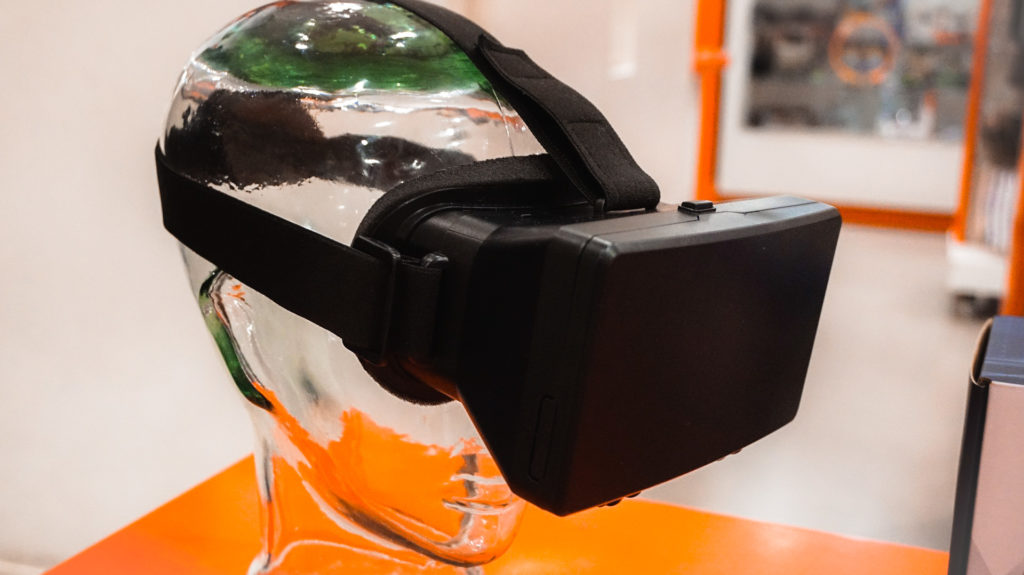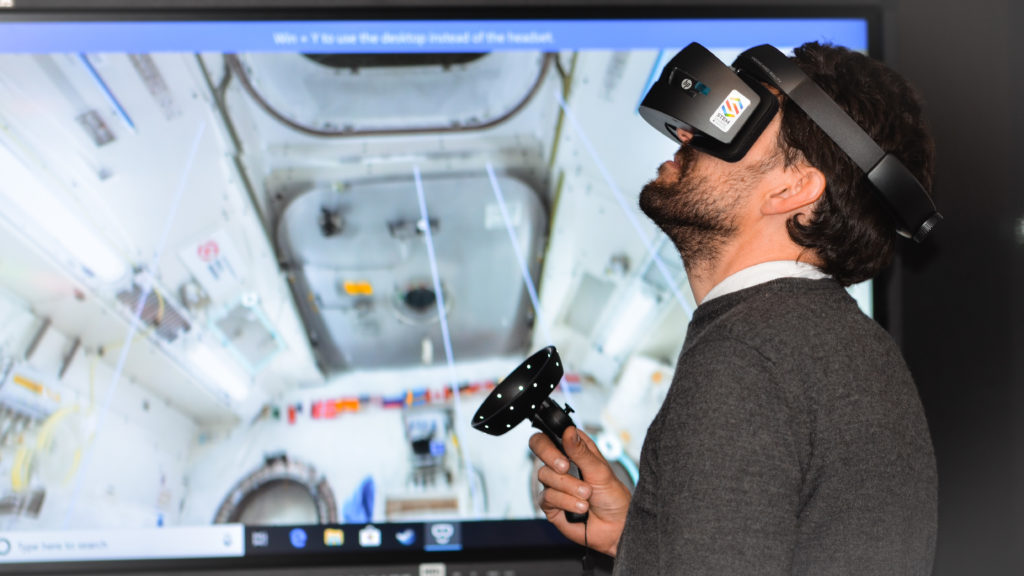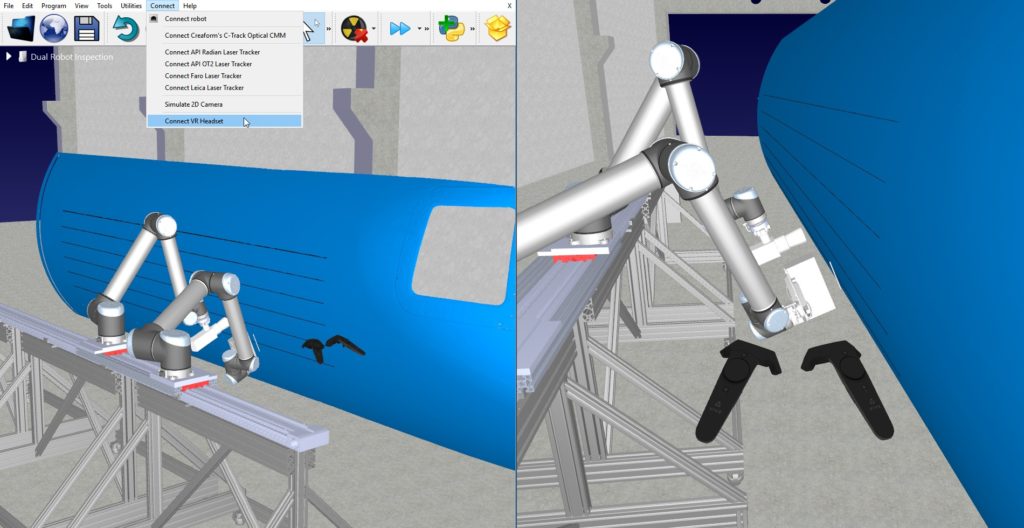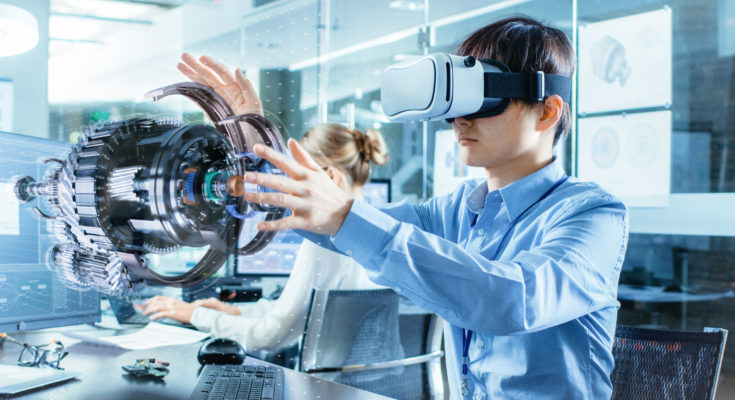We now support Virtual Reality! But, is VR really the future of industrial robotics or is it just a fun toy? Here’s an introduction to VR and OLP.
In the latest release of RoboDK, we’ve introduced support for Virtual Reality (VR) headsets. For the very first time, this allows you to get “up close and personal” with your robot simulation when doing offline programming.
The question you might be asking yourself is… Is VR “worth it” for me?
Maybe you are in two minds about VR technology:
- You might think that VR is just a “fun toy.” A fleeting fad which will never become as popular as all the hype says it will. Surely, VR will just go the way of Google Glass a technology that supposedly “died” in 2015?…
- You might be enthusiastic and keen to use VR with offline programming. Maybe you’re already using VR. Maybe you’ve just heard about it and you want to get started as soon as possible.
Alternatively, you might just be unsure. Is VR really going to benefit your business? Let’s have a look.
What is Virtual Reality?
Virtual Reality technology has been around for a surprisingly long time. It’s almost as old as robotics! The first VR headset that resembled the headsets we use today was actually invented in 1968.
Even so, VR is still quite a new concept for most people. You might have seen a demo at a trade fair or science museum but you probably don’t see VR in your day-to-day life… yet.
The technology has advanced a lot over the last decade. I remember trying out the first ever Oculus Rift developer kit back in 2012, which my research colleague had ordered for a project. The experience was a bit clunky but it was the first time that I could imagine the future of home VR. The systems I’d tried before required a whole roomful of tracking technology. This just needed a headset.

Oculus is one of the headsets that we now support in RoboDK. The technology is now much more advanced than it was when I tried it 7 years ago.
Industrial VR
Most of the advertising for VR is currently targeted at the games market. However, you’d be wrong to think that the technology is only good for playing games.
Industrial VR has been making waves in various industries for a few years now and the benefits are perhaps even more important than in consumer applications. It involves using the same VR headsets but applying them to industrial tasks.
Common examples of industrial applications include:
- Training — This is a big one. Workers are trained in a virtual environment where it doesn’t matter if they make mistakes.
- Product Testing — Digital prototypes can be used to test product designs without having to build any product at all. For example, Ford uses VR to test out the customer experience in digital models of their cars.
- Product Design — VR adds an extra dimension to product design which can improve the design from the beginning. CNH Industrial, for example, has used VR to model agricultural machinery since 2017.
Sure, the industrial applications of VR might not seem as fun or flashy as the consumer applications. But, the technology is fast becoming an indispensable tool for many businesses.
Oh yes… and don’t believe everything you read about the supposed popularity of these new technologies. You know that Google Glass technology which apparently “died” in 2015? It’s also still alive and thriving in industrial applications as Google Glass Enterprise. It’s been quietly improving productivity in businesses for 4 years now. Sometimes, the industrial uses are far more successful than the consumer ones.

Is VR Really Useful for Offline Programming Robots?
“Okay,” you might be thinking, “VR technology is quite well established in some industries… but is it really useful for offline programming robots?”
The honest answer is “you’ll have to try it to find out.”
As with many of these new technologies, it’s only when we test them out in our real processes that we are able to appreciate their effects on our business. To continue with the example of Google Glass Enterprise (which, to avoid confusion, is actually Augmented Reality, not Virtual Reality). Manufacturer ACGO started using the technology to reduce production time but simultaneously halved training time which was a complete surprise to them.
This type of unexpected gain is common with the “newer” (or let’s say “less established”) technologies. Our VR support in RoboDK is a brand new feature, so we can’t tell you exactly how much it will change your process… yet.
However, there are some preliminary benefits from other industrial VR applications which suggest that there could be significant benefits. For example, Walmart found that VR training improved employee learning by 10-15%. Manufacturer recently Genlab achieved a 20% annual production increase using a VR factory.
How RoboDK Supports Offline Programming
We’ve added support for VR using the OpenVR toolkit. This is a library which sits between RoboDK and your VR hardware, allowing you interact with the simulation environment.
What this means for you is that our VR support is riding on the back of an already well-established VR interface. We haven’t tried to develop our own VR library, which would be a recipe for a buggy, difficult experience. Instead, we’ve gone for a library which has over 4 years and hundreds of hours of VR coding, expertise and testing behind it from Valve, one of the most established computer game developers of the last 20 years.
This also means that a range VR headsets are supported “out the box”, including Oculus Rift, HTC Vive, Samsung Gear VR, and more. Any device supported by OpenVR/SteamVR should work.
We’ve already tested RoboDK with the Oculus Rift S and HTC Vive headsets with RoboDK, and they’re working well!
How You Can Try Out the New VR Support
The best way is to try it out VR is to try it out for yourself by selecting Connect-Connect VR Headset (make sure to have SteamVR installed). Obviously, there is a technology investment in the VR headset, although there are cheaper options for trying out the technology which we’ll cover in a later article.

If you have got a VR headset already, just download the latest copy of RoboDK and try out the new feature for yourself!
What are your thoughts on VR in industry? Tell us in the comments below or join the discussion on LinkedIn, Twitter, Facebook, Instagram or in the RoboDK Forum.





Great.Thank you so much for your informative post.If you are looking for a video production service, it is important to choose the right one.